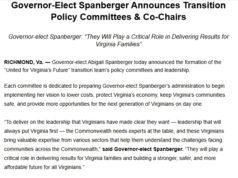( – promoted by lowkell)
 Even though I swore off doing another series of diaries at Blue Virginia on past, present, and future trends in politics, I’ve been thinking a lot about where our Commonwealth stands. Governor McAuliffee is ready to keep up the fight on Medicaid expansion in Virginia, while also laying down the foundation for a fight with the General Assembly over redistricting. As we prepare to enter into 2015, here are some random, at times disjointed thoughts on Virginia’s present and future.
Even though I swore off doing another series of diaries at Blue Virginia on past, present, and future trends in politics, I’ve been thinking a lot about where our Commonwealth stands. Governor McAuliffee is ready to keep up the fight on Medicaid expansion in Virginia, while also laying down the foundation for a fight with the General Assembly over redistricting. As we prepare to enter into 2015, here are some random, at times disjointed thoughts on Virginia’s present and future.
1. On the expansion of Medicaid, the issue isn’t just about what the Commonwealth will do for the least fortune among us. Thinking about a practical blank check from the federal government to do more today for struggling Virginians is a timely issue on the eve of Christmas. There is also an argument for asking why Virginia should be paying for the Affordable Care Act without receiving its full benefits.
But after the Supreme Court’s ruling, Republican governors and legislatures in state after state rejected the expansion. Rejecting the Medicaid expansion, however, doesn’t exempt a state from the taxes and spending cuts Obamacare uses to fund the Medicaid expansion. A September analysis from McClatchy estimated that “if the 23 states that have rejected expanding Medicaid under the 2010 health care law continue to do so for the next eight years, they’ll pay $152 billion to extend the program in other states – while receiving nothing in return.” That’s a helluva gift from (mostly) red states to (mostly) blue ones.
In the next term, the Supreme Court will rule on the claim that the law does not allow for subsidies for health insurance plans purchased on the federal exchange. Depending on the ruling, the Republican Party’s opposition to participating in the health care law will mean even fewer dollars going to Virginian families.
2. I haven’t seen a detailed analysis of the Medicaid eligible population by House or Senate district, but the numbers I’ve seen based on localities indicate that this is not just a moral issue in 2015, but a political winner in areas like Prince William County.
3. Medicaid expansion links well to redistricting reform. While usually such insider baseball is not the stuff of political campaigns, it bolsters the imagine of the Republican Party standing opposed to progress and reform.
But if that’s where we are in 2015, where are we going? Virginia is changing rapidly, and I think the great Yogi Berra’s observations ring true. “You’ve got to be very careful if you don’t know where you’re going, because you might not get there.”
What’s the vision for Virginia Democrats not just in 2015, but long term?
4. Virginia is no longer “just” a Southern state. We are far too diverse and competitive as a purple, sometimes blue state, for that. But it’s absurd to pretend that we are just another Northeast state, especially given how weak our union movement is. We are far more diverse than states like Connecticut and Massachusetts. And there’s not way we compare to New York and its major city. Let’s hope we don’t turn into New Jersey and its corruption …
5. In no particular order, some of the long term challenges for Virginia include …
… Addressing our state’s dependency on the federal government, not just directly through the military in Hampton Roads but through contracting and the civilian workforce in Northern Virginia.
I realize the above may seem offensive to some Democrats who are tired of conservatives bashing the federal government, but just think of the vibrant, robust private sector economies in places like Silicon Valley, Seattle, or Boston. Why can’t Virginia be home to that?
… Reforming our state’s higher education system. Anyone who thinks everything was just fine before Rolling Stone hasn’t been paying attention to the last few years.
… And finally, saving the greatest for last, the impacts of climate change. Aside from Louisiana, does any state stand more vulnerable to rising sea levels than Virginia? Even Republicans are starting to wake up to this fact.
Villanueva is proposing Virginia join the nine-state Regional Greenhouse Gas Initiative, which runs a cap-and-trade program for carbon dioxide emissions that has raised more than $1.8 billion for the nine states’ environmental and alternative-energy efforts since 2008 (the total exceeds $1.9 billion, if New Jersey is included, though it quit the effort in 2012).
Doing so would generate about $200 million a year for the state, the Chesapeake Climate Action Network says.
Villanueva is proposing to use half of that for efforts to ease the impact of rising sea levels in Hampton Roads. He’d direct 30 percent to energy-saving programs, 10 percent to help Southwest Virginia cope with the impact of slumping coal markets and 5 percent for renewable energy programs.
6. The biggest lesson from 2013 and 2014 should be that the Republicans can still win in Virginia, even statewide, because of lower turnout. But that doesn’t excuse us from coming up with a better vision to turn out voters.
Which leads us to tonight’s word …
factionalism
In Virginia, the Byrd machine left a legacy of anointing candidates for higher office. You either got the nod or you didn’t, and that was that. There were no competitive primaries, no dragging contests out in front of the voters. In recent years, this has continued as Virginia Democrats struggle to find a strong bench of viable candidates for office. I’ve seen more debates over Democratic primaries about who is “qualified” and who has “experience” than who has the right ideas or right vision for the job.
7. Right now, imagine that it’s 2017 and President Clinton has both Tim Kaine and Mark Warner as VP and a Cabinet official. Try to come up with not just two, but four plausible Senate appointments, and still maintain a viable bench of candidates for the 2017 statewide elections.
Can’t do, it, can you?
In other states that are rapidly trending blue, like Nevada, the Democratic Party has the challenge that many of the Democratic officials that hung on during minority status are not viable for higher office. During this fiasco with Joe Morrissey, its easy to forget that he used to be “somebody” within the House Democratic caucus. Imagine him running for higher office in the midst of this meltdown.
8. But in the future, when Virginia Democrats have the building blocks of being a majority party, the candidates can come out of the woodworks. We’ve had few Democratic primaries that have featured two candidates who are seen as equally qualified debating just the issues and their vision. Imagine what that would look like …
9. Consider for a second that the last time the Democratic Party of Virginia nominated a black candidate for statewide office was in 2001. And McEachin won the nomination over divided white opponents (Clement and Edwards) and higher Richmond area turnout due to Tim Kaine’s candidacy. How embarrassing for our party that’s that best we’ve done in the last decade plus.
10. If you look at Baskerville in 2005 (LG primary), Miller in 2006 (against Confederate apologist Jim Webb), Obama in 2008, the mixture of support given to Moran and McAuliffee in 2009 in eastern Virginia, and the performance of Fairfax in 2013, you can sort out a black voting block in the Democratic primaries in Virginia. Other than Obama, this list contains a lot of losers in primaries. The black community in Virginia is not in the driver’s seat in setting the statewide nominations.
11. On the other hand, if you look at Puckett in 2005 (LG primary), Webb in 2006, Clinton in 2008, and Deeds in 2009, you have a small snapshot of the old school rural Democratic vote in Virginia. What’s important to note is that because Virginia primaries are such low turnout affairs, even traditionally Republican counties still have staunchly liberal activists that in many ways vote like their compatriots (or comrades?) in Northern Virginia. Puckett was a non-entity outside of the 9th and parts of Southside. The same is largely true of Hillary Clinton.
12. There are a few other areas with unique voting histories. Chopra did better in the 5th District around Charlottesville, which in the past has sometimes demonstrated more contrarian voting habits in Democratic primaries. This sort of deviant voting tendencies could form the basis for future factions …
13. For the most part, the deciding vote in Democratic primaries in Virginia has been a mass of non-black, non-rural, mostly white voters in eastern Virginia. Primarily Northern Virginia. But it combines both readers of Washington Post editorials and readers of Blue Virginia.
Other than the Byrne-Connolly primary from 2008, I’m not aware of good examples of competitive primaries that have split this Democratic vote. Maybe the fight over the Arlington streetcar? The recent 8th Congressional District primary? Are there consistent divides that keep showing up? Thoughts?
14. If Virginia Democrats cannot come up with a plan to save Hampton Roads from defense cuts and rising sea levels (particularly the latter), it means Republicans can pander to the quick fix of offshore drilling and lower taxes …
15. … but a serious commitment to solving the challenges of Hampton Roads comes at a cost, a cost that other parts of Virginia may not be willing to pay.
Imagine a statewide Democratic primary in the 2020s between a candidate running on an aggressive carbon tax platform that significantly invests in Hampton Roads, versus a Dick Saslaw-clone who wants to stay the course, not rock the boat, but still delivers on traditional issues like education and health care. Northern Virginia business community versus Hampton Roads and its basic survival.
16. Eventually the inner Northern Virginia differences will be brought out to the rest of the Commonwealth. Redistricting means that there are few viable statewide Democratic candidates outside of Northern Virginia. Once local issues like livability and how to tackle sprawl will start to influence the types of candidates considering higher statewide office.
I have a vision of a possible Democratic electorate in the future that’s West Coast versus East Coast.
17. Between vibrant college town, strong tech influence in Northern Virginia, growing diversity from aspirational Hispanic and Asian communities, there’s a strong West Coast vibe to a lot of Virginia politics …
18. But we’re also still a “Virginia Way” state, with established communities of interest. Power brokers in networks of land developers and others who have the links to those in power, government contractors, and the like. That could feel very East Coast to some …
So I’ll end it here.
19. Virginia is an exciting state to follow for the next few years. But there’s a very real possibility that with new power will come factionalism and turning on each other within the Democratic Party …
20. I believe that dealing with the impacts of climate change trump almost all other issues facing the Commonwealth, but you may feel differently. What do you see as the motivating issue in Virginia in the decade to come?




![Saturday News: “Trump’s latest tariff TACO probably won’t make your life more affordable”; “The Epstein Email Cache: 2,300 Messages, Many of Which Mention Trump”; “[MTG] questions if Trump is still the ‘America First’ president”; “Jim Ryan tells all: ‘What did the Governor know, when did he know it?’”](https://bluevirginia.us/wp-content/uploads/2025/11/montage1115-238x178.jpg)







![Saturday News: “Trump’s latest tariff TACO probably won’t make your life more affordable”; “The Epstein Email Cache: 2,300 Messages, Many of Which Mention Trump”; “[MTG] questions if Trump is still the ‘America First’ president”; “Jim Ryan tells all: ‘What did the Governor know, when did he know it?’”](https://bluevirginia.us/wp-content/uploads/2025/11/montage1115-100x75.jpg)
